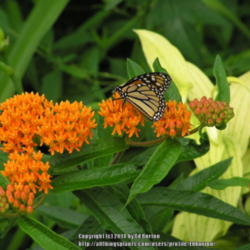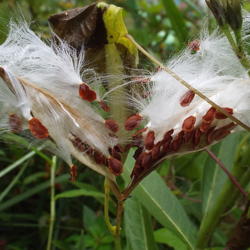By Dave Whitinger
The five oldest children in my family spend a lot of time, each spring and fall, propagating plants for a plant sale that they hold down by the entrance to our farm. They have accumulated some fame in our local area, and each sale brings out the whole community to see what kinds of interesting new plants they are offering. At each sale, without fail, they are always asked if they have milkweed, and often they are able to cheerfully answer in the affirmative. Everyone wants milkweed, primarily because everyone is concerned about monarch butterflies.
For quite some time, farmers and homeowners alike have been spraying their fields and landscapes to destroy these "weeds" and, in doing so, are removing the only host plant for this butterfly. Without being able to find milkweed, the monarchs are not able to feed and lay eggs for future generations of the insect. The US Fish and Wildlife Service has reported that since 1990, almost a billion monarchs have vanished, mostly due to this loss of habitat. Today, only about 30 million remain, and the Center for Biological Diversity has petitioned to list monarchs as an endangered species.
Could the monarchs one day actually go extinct? It's not unheard of. The stunningly blue Xerces butterfly once graced the San Francisco area, but loss of habitat destroyed them, and they have not been seen since the 1940s. Three different butterflies unique to Florida, the Florida Zestos Skipper, the Rockland Meske's Skipper, and the Keys Zarucco Skipper, were all declared extinct 2 years ago. There are other butterfly extinctions, as well.
Why do we care? Butterflies are worthy of being conserved simply because of their nature. They are part of our ecosystem's biodiversity, the monarch in particular is hugely popular, everyone loves butterflies, and they have interesting lifecycles, moving from egg to caterpillar to chrysalis to their final form. Their navigational powers are amazing and provide many opportunities for scientific research. Areas teeming with butterflies indicate a healthy ecosystem. They also are a critically important part of the food chain. On top of all that, they are pollinators for a number of blooming plants.
All right, you're convinced. How to help? Simple! Just grow some milkweed. As the monarchs are flying around looking for host plants to lay their eggs, they'll discover your plants and will come down and lay eggs for future generations. Your job is done, and you can feel good knowing you played a role in their preservation. You will also reap the educational benefits of observing their lifecycle as the eggs hatch, the caterpillar eats much of the plant, rolls itself into a cocoon, and finally emerges and flies away.
Milkweed (genus Asclepias) is actually not at all a weed. It's a beautiful, easy-to-grow, herbaceous flowering perennial that looks great in any ornamental garden. There is a wide variety of species with bloom colors ranging from white, pink, yellow, and orange to lavender, and each species has different preferred growing conditions.
Linnaeus named it after Asclepius, the mythological Greek god of healing. Pollination is accomplished in an unusual manner, where pollen is found in pollen sacs, rather than in individual grains. The feet or tongues of butterflies (and other pollinators) slip into one of the five slits in each flower, and the bases of these sacs then mechanically attach to the insect, so that a pair of pollen sacs can be pulled free when the butterfly flies off. Then, when the insect visits another flower, the reverse happens and the sac is left behind when trapped in another anther slit.
The main milkweed everyone thinks of is
Asclepias tuberosa. It has orange blooms, gets a couple feet tall, and grows in dry soil, open fields, and along roadsides. When you're offered free seeds of milkweed, this is usually the one you'll get. It works fine for the monarchs, but in my opinion it isn't particularly ornamental.
Asclepias incarnata, the 'Swamp Milkweed', is a species suited to wet areas. If you have a slough or frequently wet bottomland, this is the one to grow. It's pink blooms are lovely, with thin leaves reminiscent of willows. Another wet-soil milkweed is
Asclepias perennis, with white blooms.
East Texas gardeners will want to try out
Asclepias humistrata, also known as the Pinewoods Milkweed. It is adapted to dry, sandy, and acidic soils, and it can be grown in your pine forests quite nicely. The blooms are white/pink and quite attractive. I remember in East Tennessee seeing the
Asclepias syriaca as the common pasture milkweed, but this species seems a little more unusual in Texas. Nevertheless, if you can source seeds from this, I think you'd like it.
My favorite milkweed is
Asclepias curassavica, also known as the Tropical Milkweed. Its blooms remind me of the fiery blooms of Lantana 'Dallas Red', with brilliant red petals and yellow centers. It is evergreen and perennial, but unfortunately is often not able to withstand our winters. I usually have to replace it every couple of years, but that's a fine price to pay to grow such a stunning ornamental milkweed.
Important note: recent research is suggesting that the tropical milkweed may cause more harm than good. For now, I'm no longer recommending gardeners plant tropical milkweed, and instead stick with the species that are native to their area.
It's not always easy to find milkweed in garden centers, but fortunately they are very easy to grow from seed. You can do some Internet searching and find other gardeners who will share seeds with you, or you can buy the seeds from vendors out there. Start them at the same time as you start your tomato seedlings. Fill a flat with good potting soil, and sow the seeds 1/4" deep. Water and keep moist until germination occurs about a week later. Keep good air flow around your seedlings to prevent damping off; we use a small fan, constantly blowing over our seed starting area.
Once the danger of frost is past, you can harden off and then transplant these 6-inch plants out into your garden. They perform best in good well-drained garden soil with plenty of organic matter, and in full sun. If the soil is poor, consider adding some amendments and perhaps a gentle fertilizing schedule. Once they are growing and under way, it's easy to get more by taking cuttings from your existing plants, rooted in the usual manner.
At the end of the season, their seed pods will open revealing feathery chaff that is designed to blow the seeds far and wide with each gust of wind. Collect and save all the seeds you want for next year's garden, and for sharing with your friends!
Our plants database at Garden.org currently lists 225 different kinds of milkweeds, and we have pictures of almost all of them, along with important data points and comments that you can read. All the species and cultivars mentioned in this article are in the database and you can see them all at
https://garden.org/plants/group/milkweed/ .

Dave is the Executive Director of National Gardening Association.


